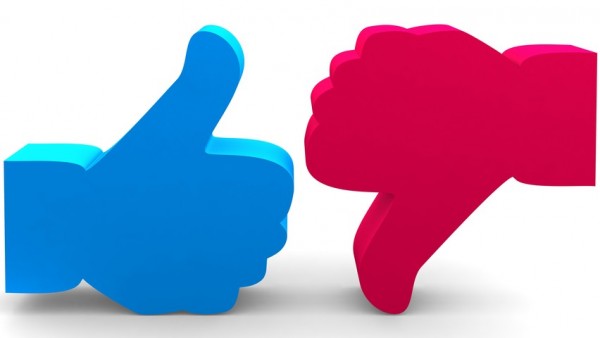Canaux
108470 éléments (108470 non lus) dans 10 canaux
 Actualités
(48730 non lus)
Actualités
(48730 non lus)
 Hoax
(65 non lus)
Hoax
(65 non lus)
 Logiciels
(39066 non lus)
Logiciels
(39066 non lus)
 Sécurité
(1668 non lus)
Sécurité
(1668 non lus)
 Referencement
(18941 non lus)
Referencement
(18941 non lus)
éléments par Jeremy Liu
BetaNews.Com
-

New survey conveys the challenges of the Windows 10 migration
Publié: juillet 18, 2018, 10:29pm CEST par Jeremy Moskowitz
It has been heralded as the last version of Windows you will ever need. This is great news for internal IT. Rather than large abrupt OS version updates such as the cumbrous leap between Windows 7 and 8, the Windows-as-a-Service delivery of Windows 10 will allow for regular incremental improvements and updates. The expectation is to eliminate the arduous elongated process of OS migrations that require significant planning, training and working hours. For those who need any further incentive, there is also the impending end-of-life deadline in January 2020 for Windows 7. Of course, to get to Windows 10, you… [Continue Reading] -

6 IoT devices you may not have considered
Publié: décembre 9, 2016, 8:03pm CET par Jeremy Cook
The Internet of Things, or IoT, seems to be the big headline in tech news lately. Perhaps you’ve heard of smart remotes, outlets, thermostats or alarm systems, but with all the recent development in this area, there are probably quite a few devices that you haven’t yet considered. Here are six worth adding to your tech radar. Wi-Fi SD Card Wi-Fi SD cards are standard-sized SD memory cards that not only contain gigabytes of storage, but can also transfer data over Wi-Fi. They allow you to whisk photos wirelessly from your camera straight onto your computer or the cloud, where… [Continue Reading] -

Mesh Networking: An alternative internet?
Publié: novembre 30, 2016, 7:19pm CET par Jeremy Cook
Currently, in order to exchange information on a computer or smartphone, we transfer it over the internet. This may take many different forms -- a web browser, email client, app or cloud storage -- but at the end of the day, you’re sending packets of information to another computer via the now-ubiquitous internet. Since we interact with this system all of the time, we no longer think about "going online". For many people, it’s just a natural state. If you step back a little bit, you’ll remember that the internet isn’t the only way to transfer computer information. Disks, CDs… [Continue Reading] -

Protecting your wireless security camera footage
Publié: septembre 8, 2016, 8:10pm CEST par Jeremy Cook
About four years ago, before I had children, I was quite surprised when friends of mine had a baby monitor with a video display -- not because I didn't think something like that was possible, but the fact that it was normal and available in a nice wireless package was striking for someone inexperienced in the baby world. Several years later, my wife now checks on our younger child every night with one. The sense of security and convenience that come with a device to instantly check on someone or something that you care about can be extremely valuable. Keeping… [Continue Reading] -

Biometrics are less secure than passwords -- this is why
Publié: août 24, 2016, 10:09am CEST par Jeremy Bergsman
Many technology pundits talk about biometrics as the ultimate authentication solution -- the technology that will make the 'imperfect' password obsolete. Despite the hype, most companies are approaching with caution. In fact, CEB found that there are varied degrees of biometrics adoption globally, as around 20 percent of firms have actually deployed the technology. A big reason for low adoption could be that they are less secure. And while many are touting the security of biometrics, there are four issues to consider when evaluating the technology. Biometrics: Already hackable? First, biometrics will be easier to hack than passwords. Not only… [Continue Reading]
Secrets2moteurs
-

[Infographie] Choisir sa landing page en fonction des autres résultats de la SERP
Publié: décembre 23, 2014, 9:30am CET par Jeremy
Définir une landing page est la base de toutes stratégies de référencement et pourtant avec les dernières modifications de l’algorithme de Google, ce n’est plus la tâche évidente que c’était il y a quelques années (mois ?).
Dans cette article vous trouverez une introduction à la notion de granularité des résultats ainsi qu’une infographie pour vous guider au mieux dans les différentes étapes pour choisir la landing Page qui correspond le mieux à votre requête.
Curieux, découvrez en plus sur le Blog de SEOh!
BetaNews.Com
-

Card fraud in the US: How EMV technology will change everything
Publié: octobre 25, 2013, 8:21pm CEST par Jeremy Gumbley
 In recent months, the US has been at the root of the global EMV discussion (the name EMV comes from Europay, MasterCard and Visa). With adoption of the new standard slow-going, the US is one of the last major economies to make the transition. As a result, it has found itself on the receiving end of fraud migrating from mature EMV markets, exposing itself as a point of weakness for fraudsters.
In recent months, the US has been at the root of the global EMV discussion (the name EMV comes from Europay, MasterCard and Visa). With adoption of the new standard slow-going, the US is one of the last major economies to make the transition. As a result, it has found itself on the receiving end of fraud migrating from mature EMV markets, exposing itself as a point of weakness for fraudsters.In 2012, 20 US states reported an increase in ATM fraud via skimmed cards according to analytics vendor Fico. Meanwhile, EMV in the UK has seen overall card fraud decrease from $275 million in 2009 to just $68 million in 2012, according to Financial Fraud Action UK. Despite this, the UK is still plagued by skimmers, with attempts to steal card holder data from ATMs almost tripling, from 2,553 to 7,525 incidents over the past year. Fraudsters can use data from the mag-stripe, which remains on Chip-enabled cards, to then clone cards and use them where mag-stripe payments are still accepted. Therefore, as long as regions such the US continue to accept mag-stripe cards to withdraw cash, there will remain a global issue of fraud migration.
The many challenges on the route to compliance are reflected in the staggered adoption rates across different markets and industry experts have begun to question the cost benefits of such a complex implementation. There is also the fundamental issue of global social responsibility and cracking down on the larger issues of criminal activity and organized crime, which the payments industry is in a prime position to address. By doing this, it can deliver the EMV benefits to merchants and banks, as well as protect cardholders.
Authentication, risk management, transaction integrity and cardholder verification are the four features that define the EMV standard, specified by EMVCo, the organization that manages the EMV standards and associated compliance processes. These are designed to protect merchants, acquirers and cardholders from fraudulent transactions.
Yet a question remains -- why has it taken so long for the world’s largest industrialized country to adopt EMV? The cost and sheer scale of implementation, especially for a country as vast as the US, is a primary restraint. Both hardware and software are affected, including every device, application and payment system. Some of this may need modifying or replacing completely, while banks must reissue the payment cards.
Rigorous testing and certification of terminals to become EMV ready, as enforced by EMVCo, is a further hurdle. All of this is a time consuming and expensive process that organizations must be prepared for as certain testing stages such as the MasterCard M-TIP (MasterCard Terminal Integration Process) can be particularly laborious. It can take up to sixteen weeks to complete in an EMV mature market, potentially causing a certification bottleneck.
Ultimately, EMV will only truly benefit the industry as whole if all regions embrace the standard and work collaboratively to stamp out fraud. The U.S. is making steady progress and is well-positioned to take advantage of being able to deploy tried and tested approaches to EMV migration. This unified approach across a global payments chain will ensure that everyone gets the full benefit and protection EMV was designed to provide.
Image Credit: nobeastsofierce/ Shutterstock
 Jeremy Gumbley became CTO and technical director at CreditCall in 2001, having spearheaded the company’s technical development since 1999. He is a veteran of the payments industry, having driven product and technology development roadmaps to accommodate EMV migration programs in the UK, Europe, Africa and the Middle East as well as the US and Canada. As CTO, he is responsible for the design, development and implementation of the company’s market leading card payment solutions and portfolio of EMV Level 2 Kernels. Under his technical leadership, the company has licensed and deployed over one million Kernels in the last decade. In addition, Jeremy oversees the maintenance of the company’s PCI DSS Level 1 compliance.
Jeremy Gumbley became CTO and technical director at CreditCall in 2001, having spearheaded the company’s technical development since 1999. He is a veteran of the payments industry, having driven product and technology development roadmaps to accommodate EMV migration programs in the UK, Europe, Africa and the Middle East as well as the US and Canada. As CTO, he is responsible for the design, development and implementation of the company’s market leading card payment solutions and portfolio of EMV Level 2 Kernels. Under his technical leadership, the company has licensed and deployed over one million Kernels in the last decade. In addition, Jeremy oversees the maintenance of the company’s PCI DSS Level 1 compliance. -

The potential success or calamity of Facebook phone
Publié: avril 1, 2013, 8:46pm CEST par Jeremy Liu

The notion of a Facebook phone has certainly lingered for a few years now -- the concept reached a point of half-hearted fruition in the HTC ChaCha and Salsa in 2011, but neither really embodied the true potential of a Facebook phone. They were much more of "throw and see what sticks" devices -- with the only tangible evidence of deeper Facebook integration being the Facebook button on the devices’ fronts.
Much has changed in nearly two years: Facebook’s Open Graph, the acquisition of Instagram and the introduction of Facebook Camera and Messenger applications, among others. Perhaps the most strident progression Mark Zuckerberg’s social network has made in the past two years is reaching 1 billion active users. And counting. That’s approximately one in seven people in the world, and an even larger proportion if accounting for the developed world alone.
It’s a number that CEO Zuckerberg wouldn’t have dared to dream in his Harvard dorm room almost 10 years ago, and a level of pervasiveness that I personally find astounding and perhaps even intimidating -- intimidating that one corporation could occupy so much global mindshare in an industry so inherently personal. You would think that a corporation with so much social leverage would be able to make some inroads in the smartphone industry.
Collecting User Data
The question: how deep can you integrate Facebook into the smartphone experience before it becomes downright intrusive, and is portrayed obviously as an overbearing corporate ploy. This is the dangerous balancing act that Facebook has to play, to integrate deeply enough to be an inescapable aspect of our smartphones and by extension our daily lives, without integrating so much as to reveal those intentions.
For Facebook, the benefits of a phone OS developed in-house are obvious. The social network is primarily an ad business and much like Google its money-making capabilities lie almost exclusively in understanding users. The more is understood about them, the more ads can be targeted at the right people. A simple mobile app that is the depth of Facebook’s current mobile strategy on most platforms provides extremely limited scope is terms of user data aggregation -- there are so many aspects of mobile usage that Facebook can’t tap into with a simple app.
If the social network built a phone to service its business motives, the device could integrate, say, Facebook places into the default mapping application and give clearer idea from where users search. The company could tap into the music and video players to ascertain the entertainment tastes of individuals. And of course Facebook could put forward a compelling case to replace SMS and calls with Facebook Messenger and free calling to other Facebook users --- augmenting subscriber reliance on the Facebook ecosystem and strengthening the ‘walled garden’.
Of course not all of these approaches may be feasible, and such invasive behavior will likely come under close scrutiny from privacy watchdogs, but the potential is certainly there. As society begins to get more comfortable with sharing more information online and as the power of ubiquity continues to grow for Facebook, now is as good a time as any for the social network to pounce with an aggressive mobile strategy.
Hamsters One and All
But how well could Zuckerberg and Company sell such a device? The HTC ChaCha and Salsa failed to really make a splash, or provide any indication that a Facebook Phone can be a hit device.
Many of us are hopelessly reliant on Facebook, and we tend to know that. We know that Facebook is among the most used apps on our phone and we check it impulsively. We scroll our News Feeds rain or shine, interesting or boring and we keep doing it even when we get nothing form the behavior. There’s a natural inclination to check the social network persistently, so would a phone built around a Facebook backbone be useful? Perhaps. Is this a selling point? Doubt it.
As much as we’ve allowed Facebook to become an ingrained aspect of our lives, we’re ashamed to admit it -- there’s a stigma attached to a Facebook reliance that we’d all love to, but wouldn’t ever shake. Facebook isn’t something people think of when buying a phone because we’re accustomed and satisfied with the accessibility of the social network on smartphones that we have now -- through an app. A Facebook phone is the answer to a question nobody has asked, which is where the real challenge lies.
To have Facebook on our smartphones left, right and center, as the very spinal core of our smartphones will inevitably increase its accessibility, efficiency and ultimately usability, but I’d vouch that there would be significant consumer trepidation about going down this route. We don’t want to get too intimate with something that is beginning to become dangerously addictive. A Facebook Phone, that is marketed as such would lack appeal for this reason alone. Facebook does not increase a phone’s marketability, we’ve learned that. Such a device would be a flop bar for one that is so exquisitely designed and offered at a bargain basement price.
But Facebook’s "Home on Android" project mightn’t be anything like this. It might not be a "Facebook Phone" in the same way that the Kindle Fire is Amazon’s tablet -- built entirely in-house with an exclusive and heavily-modified version of Android running on Amazon devices only. Such a strategy would be the anti-thesis of Facebook’s trajectory; after all, social networking is an industry which hinges entirely on pervasiveness, not exclusivity. On Thursday, Facebook will show us a modified version of Android with Facebook running through its vein in a most exquisite and beautiful manner. The company show it on a phone, of course, but not selling one. If big boy Zuckerberg unveils and intends to market a phone coupled with the Facebook-ified OS as a complete entity, then he has taken a wrong step.
Facebook has no interest in being in the hardware business, but should continue to have interest in being part of everyone else’s software -- ubiquity after all, is the key.
Photo Credit: percom/Shutterstock
-

Highlight app and the 'it's too radical to be normal' problem
Publié: octobre 22, 2012, 6:56pm CEST par Jeremy Liu

Great ideas usually take time to germinate into a model that is truly feasible. People are notoriously slow in grasping new paradigms, preferring to flirt with a comfortable present that is more often than not, entirely worthy and sufficient. This consumer mindset is an issue that faces aspiring and radical technology entrepreneurs, it is not sufficient to simply have the chops to think and execute the new ideas, but the right timing is nearly as crucial. To possess the patience and sense to release a radical idea into the wild only when the market is ripe is a factor that can determine make or break.
People discovery is a concept that has floated around the mobile app industry for quite some time. Apps like Badoo, which was founded in 2006 by a Russian entrepreneur and currently has a user base upwards of 150 million, operates around a fundamentally location-based model, by allowing users to see and interact with like-minded people around their specific region. Scores of other location-based apps, such as Banjo and Sonar, have managed to find relative success in their respective niches as location tag aggregators over various social networks and as friend-finding systems.
Solving Problems People Don't Have
However, none of these apps have managed to crack into the notion of "passive people discovery" -- a concept that is far more daring and out of sync with a current person’s typical lifestyle. Highlight, an iPhone-exclusive application is perhaps the only app that has pursued this vision right from its inception without pivoting into more conservative and "present-day friendly" fields. Highlight co-founder and CEO Paul Davison’s determined and unwavering pursuit of this utopia, where "you’ll walk into a room and know everyone’s name" is admirable, however his app and his team have paid the price for ignoring the warning signs. Highlight boasts a mere 5,000 daily users according to AppData, which is down from approximately 9,000 back in May.
The sad truth is that nobody actually goes out with the expectation or intention of meeting and discovering new people along the way. For instance, if I was riding the subway to work, the idea that I would happen to stumble across my new best friend during transit is something of an outlandish view, and a wildly optimistic one too. Many people have taken this fact along with Highlight’s declining influence as reason to dismiss "passive people discovery" as a niche concept far too obscure to ever succeed. The short-sightedness of a claim like this, however, is embarrassing.
For example, Kirill Sheynkman of RTP Ventures says "a lot of these apps come from a problem that 99 percent of people don’t have". Sure it’s a problem that almost nobody has, but is the app really trying to solve a problem? Is it a requirement that all apps be born out of a problem that needs to be solved? Highlight was never designed to be the kind of app that would allow people to scour the streets of downtown in order to find interesting people to meet up with. When you look at it from this perspective then Sheynkman is certainly correct, an inability to find cool and interesting people within a certain distance radius isn't exactly a societal problem that people scream to be fixed. But if we’re kicking back with a coffee and find a great person to talk to in the same café, then we’d certainly be glad that the app’s there.
Evidently, Highlight has its merits and theoretically speaking, Paul Davison’s vision for the app and the future of social encounters is appealing and enticing -- it just needs a few more things to fall into place for it to be viable. Something as radical as Highlight isn’t the type of app to go viral and bask in exponential adoption rates, at least not now. The consumer is a hypocritical entity -- far too fickle to take for granted but also far too invested in current trains of thought and behavior to embrace unconventional breakthroughs.
Someone To Watch Over Me
Privacy is the tallest hurdle that Highlight has to jump over, and it’s a remarkably tall one too. The main criticisms of Highlight from opponents of the app have been simply the fact that it’s "creepy", as if it’s just inherently disturbing for like-minded people to realize that you exist within close proximity. For the sake of the app it would be preferable if the main criticisms were "it kills my battery" or "it’s intensely laggy" because those faults can be ironed out through engineering. You can’t engineer social sentiments, at least not in the sense that would exist in Davison’s nature -- through streamlining code.
The extent to which the consumer backlashes at the mere thought of being watched without explicit knowledge can be summarized adequately by looking back at the Carrier IQ scandal. Carriers and phone manufacturers installed the Carrier IQ software onto many phones, tracking the cellphone’s user activity. The ultimate aim of this tracking was simply for the purposes of troubleshooting and diagnosis; however, this reassurance offered no succour for an already enraged and compromised consumer collective. The scandal raised an important discovery of particular pertinence to companies meddling with user data -- consumers are intimidated by the idea of being watched, even if it’s for their ultimate benefit. This issue runs contrary to the trajectory of Highlight, which necessitates analyzing user data and usage patterns in order to deliver results of greater interest and relevance.
So how does Highlight overcome such a prohibitive consumer mindset? Well, it can’t because the consumer simply isn’t ready and now simply isn’t the time. Warming up to the idea of "passive people discovery" will require people to warm up to the idea of having publicly accessible information follow them around like a cloud above their heads. And for many and most users, this level of transparency exceeds the boundary with which they are comfortable.
Facebook is the best example of great timing. Right from its inception it has gradually worked towards greater transparency. User backlash has been evident, but its impact on Facebook’s growth has been negligible. CEO Mark Zuckerberg got people accustomed to the idea of sharing initially with the "what’s on your mind" status prompt, and then he let our friends see what things we "became fans" of. Then he changed "become a fan" to "like" because nobody becomes a fan of things in the real world, we simply like them -- subtly breaking down the wall between our real world and our regulated privacy clad online persona. By making the notion of sharing much more palatable, the company then enabled location-based sharing and more recently, seamless and frictionless sharing through its Open Graph API.
Siri Shows How Future-Tech Fails
Timing is a factor that can explain why certain technologies which were deemed potentially industry-shifting haven’t found legitimate practical use. Siri on the iPhone demonstrates this; it was poised to be a game changer when released with the iPhone 4S. In the advertisements, Siri seems like a game changer. To the user, it is just an entertaining gimmick.
You could argue that it’s because Siri doesn't do anything as well as it should -- an Android apologist certainly would -- but the truth is, it does. Perhaps not to the extent that the ads portray it, but it certainly suffices in providing quick answers to everyday questions that would normally require us to jump through hoops to find. Sure it’s gimmicky, but it’s more than that. Samsung, through its S Voice emulates Siri, clearly seeing the potential in the idea of the "virtual assistant".
The truth as to why Siri has been deemed by many as one of the most overrated and impractical innovations in the mobile industry is because talking to your phone is just weird. Such behavior hasn't yet entirely transcended the realm of science fiction, or the geek universe. It’s too radical to be normal. Nobody wants to get caught on the train talking to their know-it-all friend Siri.
If Apple had allowed Siri queries through text as opposed to simply speech, its practicality and use would probably be significantly higher. Text entry is a much more subtle form of communication, and users need to be eased into the idea of talking to their phones, instead of having the concept dumped on them.
Google Glass is another example, an idea that will change the world one day but is far too futuristic to digest now. Once people get acquainted to the idea of technology merging seamlessly with the way we live, then people will discover the appeal of Google Glass.
Being a forward-thinking technology entrepreneur is both a blessing and a curse. The ability to think, imagine and develop in anticipation of a distant future is an immeasurable gift, but many would be too smart to realize that society will be slower to catch up and much less open to embracing new ideas. This is Davison’s dilemma; he’s developed for a future that the market simply isn't ready for yet. People aren't prepared to open up to a level of transparency that is necessary for an app like Highlight, but we’re getting there. When that time comes, Highlight will be in an environment where it can gain the pervasiveness in order for it to succeed.
Photo Credit: Oleksiy Mark/Shutterstock
 Jeremy Liu is a high school student who first became obsessed with technology in the 8th grade when his father bought him an iPod touch after months of begging. At a time when iPhones and the iPod Touch were spectacularly rare, the device managed to fascinate both himself and his friends. Liu now shuns the mainstream and roots for underdogs, owning a Windows Phone, Blackberry PlayBook and Sony Walkman X. Since then technology has grown from a passion to an obsession and he now directs his energies towards writing. You can find him on Facebook, Google+ and Tumblr.
Jeremy Liu is a high school student who first became obsessed with technology in the 8th grade when his father bought him an iPod touch after months of begging. At a time when iPhones and the iPod Touch were spectacularly rare, the device managed to fascinate both himself and his friends. Liu now shuns the mainstream and roots for underdogs, owning a Windows Phone, Blackberry PlayBook and Sony Walkman X. Since then technology has grown from a passion to an obsession and he now directs his energies towards writing. You can find him on Facebook, Google+ and Tumblr. -

Apple vs Samsung: The defense of common sense
Publié: août 14, 2012, 6:47pm CEST par Jeremy Liu
 The transpiring events of Apple’s lawsuit against Samsung divides the technology industry and hones in on several overarching intellectual property talking points and issues that far extend the perpetual "eye for an eye" battle the companies occupy. Many writers and pundits state that the lawsuit will be a primary stepping stone to IP and patent reform and will be a primary decider of the future of patent law in the technology industry.
The transpiring events of Apple’s lawsuit against Samsung divides the technology industry and hones in on several overarching intellectual property talking points and issues that far extend the perpetual "eye for an eye" battle the companies occupy. Many writers and pundits state that the lawsuit will be a primary stepping stone to IP and patent reform and will be a primary decider of the future of patent law in the technology industry.What the trial really rises to the surface: the two differing approaches with which Apple and Samsung view the situation. Apple’s perspective hinges on protecting the intrinsic and unique value of their intellectual property, whereas Samsung focuses more on the end game of consumer perception.
What both these approaches share: none can be tied to any semblance of pure rationality or cold hard facts; there’s no way to say with certainty, for example, that the use of a certain color scheme in Samsung’s iconography directly led to loss suffered by Apple, nor can it be said that Apple’s design is generic and therefore should offer no direct or exclusive benefit to the company. Both these conclusions assume direct causation and attempt to put some logic behind something that inherently isn’t logical -- perception and behavior.
Not so Sensible
In Samsung's defense, many apologists make the common-sense argument, which is once again based purely on perception. What one deems to be common sense could be grounded in a variety of experiential factors, but nonetheless the argument of common sense and obviousness does bring to light several indisputable points.
Like the color green, for instance; Samsung has vehemently argued that the green phone icon can’t possibly go any other way. After all, green as a universal standard means "go" and if that color was to be attributed to any basic function of a smartphone it would most certainly be its namesake -- the phone.
But, of course, the common-sense argument goes much further than that and not particularly in Samsung’s favor. Based on experience and past evidence, we can conclude that it’s easy to argue common sense when it’s already been successfully implemented by someone else. After all, if a successful implementation of something proves nothing else, there is indeed at least some sense behind it.
A look at Samsung's phones pre-iPhone and post-iPhone display a fairly damning picture of this notion. Samsung’s pre-iPhone lineup is seemingly laden with devices thrown into market with the hope that something would stick, whereas Samsung’s post-iPhone lineup is the polar opposite exhibiting uniformity and purpose in form factor and design.
Nokia in their heyday, before the iPhone, were recognized for the pure variety of their handset lineup and also the mindless creativity in the design of many of their devices. Essentially Nokia defined cool in the cellphone industry, and that coupled with economies of large scale moved phones effortlessly off the shelves. Nokia’s approach of spread therefore was deemed an obvious and logical means with which to penetrate the cellphone market -- and Samsung followed suit.
Flipping the Paradigm
Apple’s iPhone literally flipped this paradigm and showed that a device that exhibited simplicity in lineup and product could move even faster off the shelves. Simplicity and fluidity in design are two aspects that make the iPhone sell, so why not emulate that? And why would you do it any other way, it’s just common sense.
Obviously these successful approaches have sense and prudence, but a nascent notion that a new-found successful way is the only appropriate way is far off base -- this point alone is the most prominent gaping hole behind the "common sense defense" that no doubt Samsung has in its card and many of Samsung’s supporters are ready to play in heated fanboy debates. Whether Samsung had or hadn’t the intention of copying Apple’s design is not the epicenter of the debate, it’s that Samsung, regardless of intent did produce a design that resembled Apple’s when other options were and are available.
It’s difficult to think laterally when there’s a standard that’s trying to be reached -- that is, Samsung would certainly have found it a mind-stretch to build a differentiated product when the iPhone in all its rounded rectangle and gridded icon glory was the benchmark to reach. It is a sound presumption that a Samsung product would brandish much more originality if the company were forced to think and develop from the ground up instead of basing thought around a readily set standard.
It doesn’t make it easier when the design that the frontrunner has settled on, despite not being the sole logical approach, is certainly one that exercises basic no-frills simplicity to its absolute core. To think of a logical and aesthetically pleasing design as simplistic as the original iPhone is a tall ask, and the case applies even more so with the iPad, which is essentially a skeletally bare slab of aluminium and glass. And what’s more simple than an evenly arranged grid of uniformly shaped icons?
Tablet Zero
Devin Coldewey of TechCrunch alludes to this point better than anyone else in his article "Tablet Zero" from December of 2011. Apple went out of their way to develop a design so generic that its form would become the start line for any manufacturer willing to join the race. As Devin Coldewey writes: "You can’t make a Xoom without making an iPad first, just like you can’t make a die without making a cube first. This was Apple’s stroke of evil genius".
Apple’s sly tactics are still no excuse and can’t form the basis of a defense for Samsung, because even though claiming ownership to a generic form factor and design shouldn’t be allowed, this doesn’t change the fact that there are still many unexplored opportunities that make equally as much sense and are equally as feasible regardless of whether they’re as simple or not. A black slab of glass is not plainly a given in smartphone hardware design and the rounded rectangle icon style isn’t any more commonsensical or intrinsically better than the tile-based UI in Windows Phone.
Sure Apple gets the perhaps unfair advantage of having their all-encompassing design immediately compared against competing alternatives, but that’s just one of the perks of getting to market first. Apple deserves credit where credit is due.
The underlying point is that there are still plenty of opportunities to make a functionally and useably better device without aligning with Apple’s plan of attack so closely. That being said, there are far too many ways for a design to be commonsensical to excuse Samsung’s phones of bearing such a level of similarity, no matter how significant the granular details. This is a gaping hole in the entirety of Samsung’s defensive case.
Photo Credit: Nomadia/Shutterstock
 Jeremy Liu is a high school student who first became obsessed with technology in the 8th grade when his father bought him an iPod touch after months of begging. At a time when iPhones and the iPod Touch were spectacularly rare, the device managed to fascinate both himself and his friends. Liu now shuns the mainstream and roots for underdogs, owning a Windows Phone, Blackberry PlayBook and Sony Walkman X. Since then technology has grown from a passion to an obsession and he now directs his energies towards writing. You can find him on Facebook, Google+ and Tumblr.
Jeremy Liu is a high school student who first became obsessed with technology in the 8th grade when his father bought him an iPod touch after months of begging. At a time when iPhones and the iPod Touch were spectacularly rare, the device managed to fascinate both himself and his friends. Liu now shuns the mainstream and roots for underdogs, owning a Windows Phone, Blackberry PlayBook and Sony Walkman X. Since then technology has grown from a passion to an obsession and he now directs his energies towards writing. You can find him on Facebook, Google+ and Tumblr.